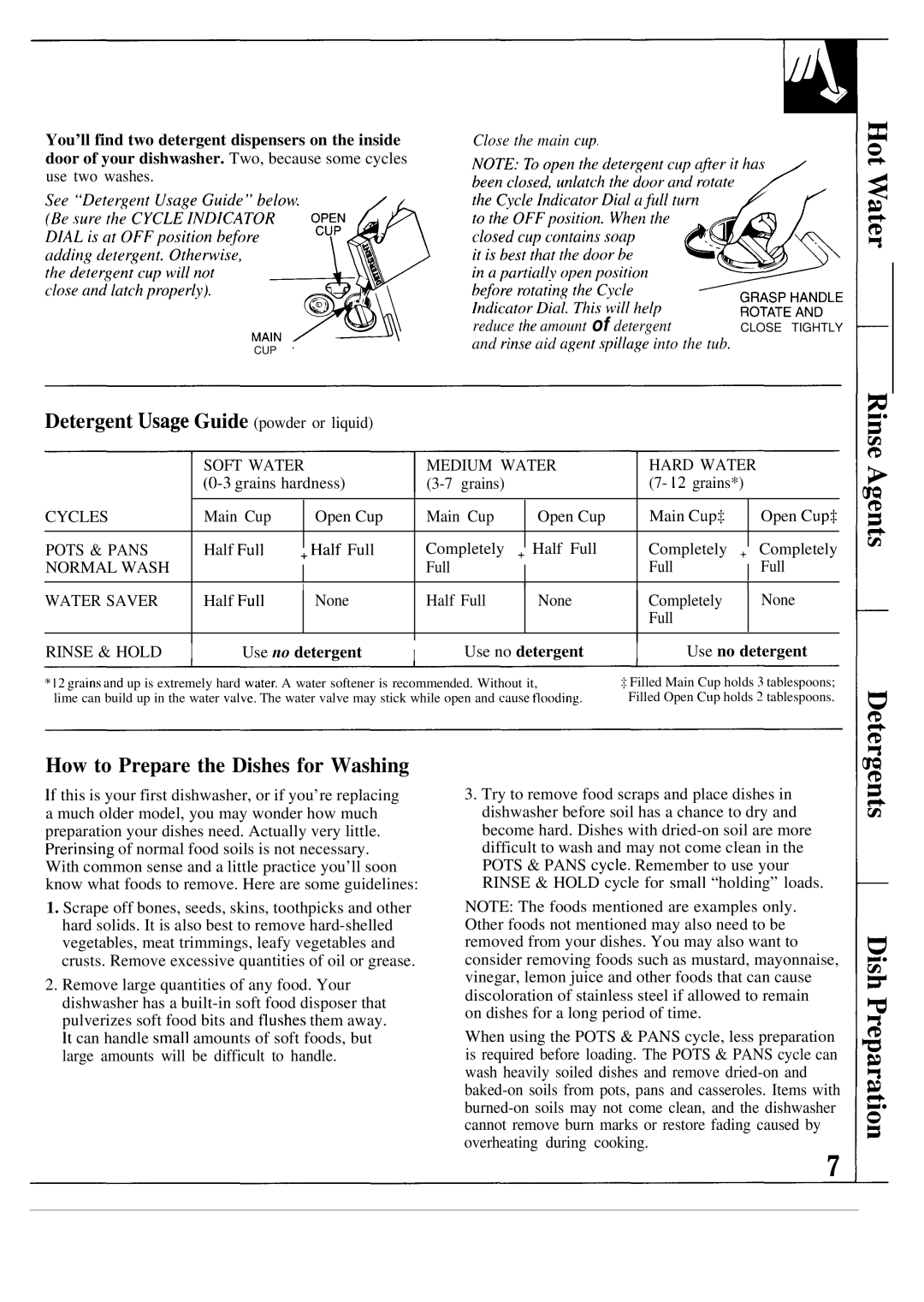
You’ll find two detergent dispensers on the inside door of your dishwasher. Two, because some cycles use two washes.
CUP ‘
Close the main cup
reduce the amount of detergent | CLOSE TIGHTLY |
and rin.~e aid agent .~pillage into the tub. |
|
Detergent Usage Guide (powder or liquid)
|
|
| SOFT WATER | MEDIUM WATER |
|
| HARD WATER |
| ||||||||||
|
|
| grains) |
|
|
|
| (7- 12 | grains*) |
| ||||||||
|
|
|
|
|
|
|
|
|
|
|
|
|
|
|
|
| ||
CYCLES |
|
| Main Cup |
|
| Open Cup | Main Cup |
|
| Open Cup |
|
| Main Cup$ |
|
| Open Cup$ | ||
|
|
|
|
|
|
|
|
|
|
|
|
|
|
|
|
| ||
POTS & PANS |
|
| Half Full | + Half Full | Completely | + |
| Half Full |
|
| Completely + |
|
| Completely | ||||
|
|
|
| |||||||||||||||
NORMAL WASH |
|
|
|
|
|
| Full |
| I |
|
|
| Full |
| I |
| Full | |
|
|
|
|
|
|
|
|
| ||||||||||
|
|
|
|
|
|
|
|
|
|
|
|
|
|
|
| |||
WATER SAVER |
|
| Half Full |
| I |
| Half Full | None |
|
| Completely |
| None | |||||
|
|
|
| None |
|
|
|
|
|
| ||||||||
|
|
|
|
|
|
|
|
|
|
|
|
|
| Full |
|
|
|
|
|
|
|
|
|
|
|
|
|
|
|
|
|
|
|
| |||
RINSE & HOLD |
|
|
|
|
|
|
|
|
|
|
|
|
|
|
|
|
|
|
I | Use no detergent | I | Use no detergent | I | Use no detergent | |||||||||||||
*12 grains and up is extremely hard water, A water softener is recommended. Without it, | :\: Filled Main Cup holds 3 tablespoons; | |||||||||||||||||
lime can build up in the water vtilve. The water valve may stick while open and cause tlooding. | Filled Open CLIp holds 2 tablespoons. | |||||||||||||||||
How to Prepare the Dishes for Washing
If this is your first dishwasher, or if you’re replacing a much older model, you may wonder how much preparation your dishes need. Actually very little. Prerinsing of normal food soils is not necessary. With common sense and a little practice you’ll soon know what foods to remove. Here are some guidelines:
1.Scrape off bones, seeds, skins, toothpicks and other hard solids. It is also best to remove
2.Remove large quantities of any food. Your dishwasher has a
3.Try to remove food scraps and place dishes in dishwasher before soil has a chance to dry and become hard. Dishes with
NOTE: The foods mentioned are examples only. Other foods not mentioned may also need to be removed from your dishes. You may also want to consider removing foods such as mustard, mayonnaise, vinegar, lemon juice and other foods that can cause discoloration of stainless steel if allowed to remain
on dishes for a long period of time.
When using the POTS & PANS cycle, less preparation is required before loading. The POTS & PANS cycle can wash heavily soiled dishes and remove
7
